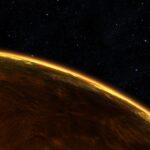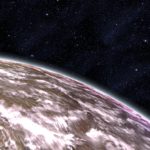System Specs:
- Stellar Mass: N/A Sol Masses
- Stellar Class: N/A
- Luminosity: N/A Sol
- Planets: 4
- Moons: 0
- Asteroid Belts: 1
- Asteroids: 0
- Objects: 0

The Styx Theta cluster and the systems within it are named for the Greek underworld, Hades. The name of Erebus, a god representing the personification of darkness and shadow, came to be applied to a portion of the underworld itself.
Erebus was surveyed by the Systems Alliance ship Ibn Battuta, which specifically surveyed Chofen and Quaji. The ship is named after Ibn Battuta, a famous 14th century Moroccan traveler and explorer who has a crater on the Moon named after him.
–
Planets Directory:
- Nepmos
- asteroid belt
- Quaji
- Wermani
- Chofen
–
Nepmos:

- Orbital Distance: N/A AU
- Orbital Period: 0.7 Earth-years
- Keplerian Ratio: N/A
- Radius: 7,593 km
- Day Length: 68.1 Earth-hours
- Atmospheric Pressure: 1.12 atm
- Surface Temp: 68 °C
- Surface Gravity: 1.2 g
- Mass: 1.688 Earth-masses
Nepmos is a resource-rich terrestrial world somewhat larger than Earth, with a dense atmosphere of sulphur dioxide and argon. Nepmos’ crust is very thin and unstable, not more than 8 kilometers deep in any location. Subsurface magma flows are a hazard to ground travel, and earthquakes are frequent. While heavy metals and radioactives are plentiful, this geological instability has deterred investment by mining concerns.
An additional complication is that the Styx Cluster lies uncomfortably close to the “Five Kiloparsec Ring” around the galactic core. The Ring contains a great deal of molecular hydrogen, fueling the majority of the galaxy’s star formation. This area is too dangerous to safely travel.
–
Quaji:

- Orbital Distance: N/A AU
- Orbital Period: 2.9 Earth-years
- Keplerian Ratio: N/A
- Radius: 5,160 km
- Day Length: 38.7 Earth-hours
- Atmospheric Pressure: 0.83 atm
- Surface Temp: −7 °C
- Surface Gravity: 0.8 g
- Mass: 0.52 Earth-masses
Quaji is a terrestrial planet with an atmosphere of methane and ethane. The surface is composed of silica with deposits of uranium and heavy metals. Clouds of small water ice crystals are common. Quaji’s skies are full of fine silica dust. From the surface, the sky has a pronounced salmon hue.
The cursory initial scans from the Alliance surveyor ship Ibn Battuta showed geometric patterns in the northern hemisphere deserts, visible only in the ultraviolet band. Normandy’s sensors see nothing of the kind.
–
Wermani:

- Orbital Distance: N/A AU
- Orbital Period: 9.9 Earth-years
- Keplerian Ratio: N/A
- Radius: 71,541 km
- Day Length: N/A Earth-hours
- Atmospheric Pressure: N/A atm
- Surface Temp: N/A °C
- Surface Gravity: N/A g
- Mass: 9.2 Earth-masses
Wermani has only been visited once by a single, unmanned probe. It is a standard hydrogen-helium gas giant with large formations of water vapor clouds in the atmosphere.
Survey Text
“Scans of the planet Wermani turned up a few odd readings. Chief Engineer Adams fine-tuned the scans and discovered an automated repair drone in orbit. Tali and Adams brought the drone on board to dismantle it and found a Prothean data disc at its core.”
–
Chofen:

- Orbital Distance: N/A AU
- Orbital Period: 56.9 Earth-years
- Keplerian Ratio: N/A
- Radius: 21,481 km
- Day Length: 13.7 Earth-hours
- Atmospheric Pressure: N/A atm
- Surface Temp: N/A °C
- Surface Gravity: N/A g
- Mass: N/A Earth-masses
Chofen is an unusually small hydrogen-helium gas giant, with traces of sulphur and hydrocarbons in the atmosphere. The Alliance surveyor ship Ibn Battuta provided inconclusive evidence of hydrocarbon life in the atmosphere (over 1,000 meters below the cloud tops), where pressure compresses Chofen’s hydrogen into a liquid state.
Proof of life in the atmosphere would prove many long-standing theories. Unfortunately, only a probe with extremely expensive mass effect generators could survive the crushing pressure long enough to send back useful data – and the probe would be lost in the attempt. Simple expense makes investigation doubtful.
Trivia
Chofen is too small to be a “hydrogen-helium gas giant” (William Hubbard, The New Solar System 4th ed, 1999; p. 194). In the amount of energy from the sun and in its radius, it is most like to Uranus. Hydrogen is not compressed to a liquid state in such an environment; instead, the hydrogen atmosphere merges with a water / methane / ammonia ocean.
–
–
video






